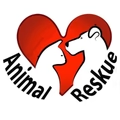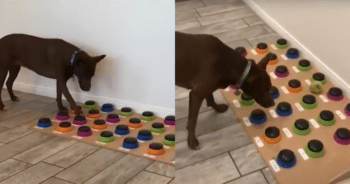Ever wondered what your dog might say if it could talk? Speech pathologist Christina Hunger, MA, CCC-SLP, turned that curiosity into a groundbreaking experiment with her dog, Stella. Using her expertise in communication development, Hunger taught Stella to express herself through a specially designed Augmentative and Alternative Communication (AAC) device — a tool typically used by non-verbal children.
Stella, a Catahoula/Blue Heeler mix, now uses 29 words to express her thoughts, needs, and feelings. Hunger began training Stella when she was just 8 weeks old, recognizing early on that dogs, like humans, communicate in multiple ways — through behavior, vocalization, and body language. What if dogs had access to words we say to them every day? That question sparked the creation of Stella’s button-based communication system.
Similar to AAC devices used in speech therapy, Stella’s word board features buttons that play audio of words when pressed. Hunger and her fiancé, Jake, started with a single word — “outside.” Every time they let Stella out, they pressed the word button, reinforcing the connection between the action and the word.
Within a few weeks, Stella began to understand and interact with her button system. She started by barking and looking at the “outside” button when asked about going out. Encouraged by this progress, Hunger added more essential words to Stella’s board:
- eat
- water
- play
- walk
- no
- come
- help
- bye
- love you
These words were carefully chosen to reflect Stella’s daily life and interactions. Instead of using treats as a reward for pressing a button, Hunger emphasized genuine interaction. Stella received what she asked for — a walk, water, or play — reinforcing meaningful communication over performance.
Stella quickly began using the buttons independently and appropriately. She would say “play” repeatedly to initiate playtime or “water” when her bowl was empty. If a toy rolled under the couch, she’d say “help” and wait by the spot needing attention. These were no longer just button presses — they were intentional acts of communication.
Her communication soon became increasingly complex. Stella started combining words to create short phrases that better conveyed her thoughts:
- “no eat” — when her dinner was late
- “eat play” — referring to her food-stuffed toy
- “help come” — signaling she wanted assistance in another room
- “walk no” — showing discontent at a missed walk
One particularly insightful moment came when Stella pressed “water” as Hunger was watering plants, even though Stella’s bowl was full — indicating that she connected the spoken word “water” with its context, not just her own need.
Emotionally expressive uses of language followed. After being made to wait for dinner, Stella once pressed “love you no” before walking away — a remarkable example of canine emotional intelligence and the ability to express complex feelings through language. Such moments serve as a powerful reminder that dogs may understand and feel more than previously assumed.
According to research, the average dog can recognize around 165 human words. What sets Stella apart is her ability to actively use those words via technology to initiate conversation, make observations, and form relationships. This project not only provides important insights into the intelligence and emotional capacity of dogs but also fosters a deeper, more respectful relationship between humans and their four-legged companions.
Watch the full video of Stella’s incredible journey here:











Facebook Comments